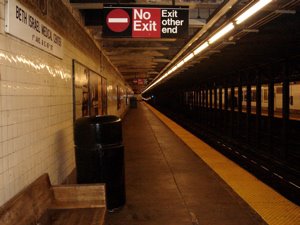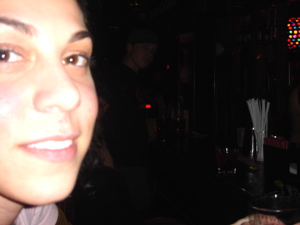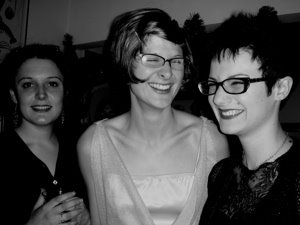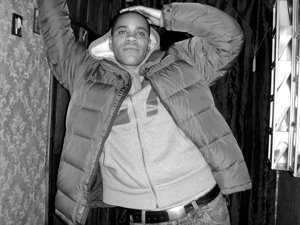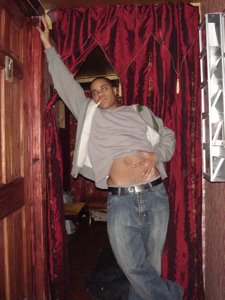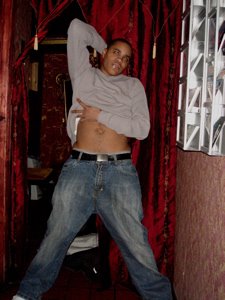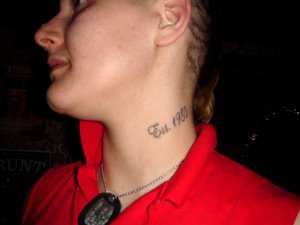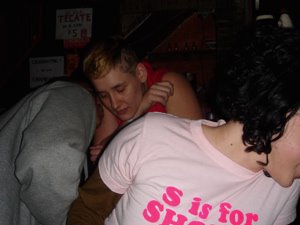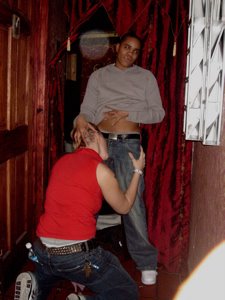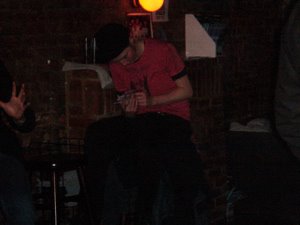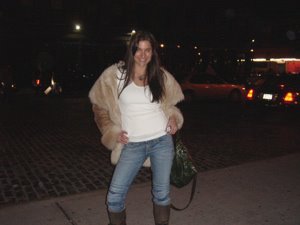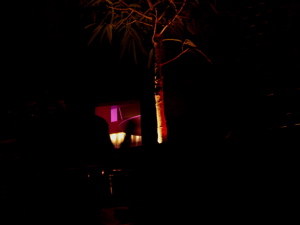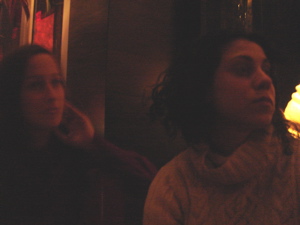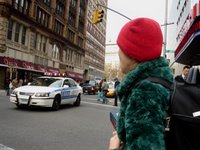Thursday, December 29, 2005
Wednesday, December 28, 2005
Monday, December 26, 2005
Thursday, December 22, 2005
Wednesday, December 21, 2005
Theaters To Go Digital -- By the Thousands
In a move that is likely to force the transition to digital projection in movie theaters, Carmike Cinemas, the nation's third-largest chain, said it would convert 2,300 auditoriums to digital by October 2007. The projectors will be provided by Christie Digital Systems Inc., while software will come from Access Integrated Technologies, Inc. Currently only about 100 theaters in the U.S. are equipped with digital systems. Bud Mayo, AccessIT's CEO, told the London Financial Times: "It would be hard to exaggerate the significance of today's development as a major milestone for the industry and for our respective companies." And in an interview with today's (Tuesday) Los Angeles Times, industry analyst Dennis McAlpine remarked, "Most of the [deals] have been bits and pieces. ... I think this is the one that says, 'OK, everyone is going to have some digital.'" --imdb
Dear Carmike,
You should spend your money (i.e. chapter 11 four years ago) on cleaning your theaters. They are a disgrace. And give your employees raises, at least every two or three years. Think about it.
Sincerely,
Nicole
Post Script: you are all fucking douchebags.
In a move that is likely to force the transition to digital projection in movie theaters, Carmike Cinemas, the nation's third-largest chain, said it would convert 2,300 auditoriums to digital by October 2007. The projectors will be provided by Christie Digital Systems Inc., while software will come from Access Integrated Technologies, Inc. Currently only about 100 theaters in the U.S. are equipped with digital systems. Bud Mayo, AccessIT's CEO, told the London Financial Times: "It would be hard to exaggerate the significance of today's development as a major milestone for the industry and for our respective companies." And in an interview with today's (Tuesday) Los Angeles Times, industry analyst Dennis McAlpine remarked, "Most of the [deals] have been bits and pieces. ... I think this is the one that says, 'OK, everyone is going to have some digital.'" --imdb
Dear Carmike,
You should spend your money (i.e. chapter 11 four years ago) on cleaning your theaters. They are a disgrace. And give your employees raises, at least every two or three years. Think about it.
Sincerely,
Nicole
Post Script: you are all fucking douchebags.
Tuesday, December 20, 2005
Monday, December 19, 2005

this is from this dude.....i love his site, everyday. This picture just made me so happy, which i haven't been in days....
I will also mention that I was in Park Slope Saturday evening to attend "the love of my life"'s party. It was nice that SHE finally admitted to such feelings, as I have felt them for years. To be introduced as such, was charming. The party was fantastik, as I chatted away with an old friend. she is the reason love was invented. thanks for the talk. felt like home, for once.
Friday, December 16, 2005
Thursday, December 15, 2005
Wednesday, December 14, 2005
Tuesday, December 13, 2005
i feel like a widow. a widow in a war who knows she lost her husband in war. who had that moment in her day, when she paused, like in a movie, when she looked up and knew he was gone. she knew he was dead but had to wait for formal news before she did anyting drastic. like a pin prick to my heart I can't act until all the blood has poured out of the tiny wound so painfully slow. that's when i will colapse and die. what a tragic day indeed.
Monday, December 12, 2005

What is SAD?
Throughout the centuries, poets have described a sense of sadness, loss and lethargy which can accompany the shortening days of fall and winter. Many cultures and religions have winter festivals associated with candles or fire. Many of us notice tiredness, a bit of weight gain, difficulty getting out of bed and bouts of "the blues" as fall turns to winter.
However some people experience an exaggerated form of these symptoms. Their depression and lack of energy become debilitating. Work and relationships suffer. This condition, known as Seasonal Affective Disorder (SAD) may affect over 10 million Americans while the milder, "Winter Blues" may affect a larger number of individuals.
The typical symptoms of SAD include depression, lack of energy, increased need for sleep, a craving for sweets and weight gain. Symptoms begin in the fall, peak in the winter and usually resolve in the spring. Some individuals experience great bursts of energy and creativity in the spring or early summer. Susceptible individuals who work in buildings without windows may experience SAD-type symptoms at any time of year. Some people with SAD have mild or occasionally severe periods of mania during the spring or summer. If the symptoms are mild, no treatment may be necessary. If they are problematic, then a mood stabilizer such as Lithium might be considered. There is a smaller group of individuals who suffer from summer depression.
SAD is recognized in the DSM-IV (The American Psychiatric Association's diagnostic manual) as a subtype of major depressive episode. The classic major depression involves decreased appetite, decreased sleep, and often, poor appetite and weight loss. It has long been recognized that some depressed individuals had a "atypical depression" with increased sleep and appetite along with decreased energy. Some, but not all of these atypical individuals also had a seasonal pattern. Some people with winter depression also have mild or occasionally severe manic mood swings in the spring and summer. If these episodes are severe, the individual might be diagnosed with Bipolar Disorder. (formerly called manic depressive illness)
Epidemiology of SAD
About 70-80% of those with SAD are women. The most common age of onset is in one's thirties, but cases of childhood SAD have been reported and successfully treated. For every individual with full blown SAD, there are many more with milder "Winter Blues." The incidence of SAD increases with increasing latitude up to a point, but does not continue increasing all the way to the poles. There seems to be interplay between an individual's innate vulnerability and her degree of light exposure. For instance, one person might feel fine all year in Maryland but develop SAD when she moves to Toronto. Another individual may be symptomatic in Baltimore, but have few symptoms in Miami. Some individuals who work long hours inside office buildings with few windows may experience symptoms all year round. Some very sensitive individuals may note changes in mood during long stretches of cloudy weather.
Theories about how light affects mood and sleep
In 1984, a psychiatrist at NIMH, Norman Rosenthal, published a paper on the use of bright light therapy in patients with this disorder. Since then, a large number of well-designed studies have confirmed and refined these findings. Researchers are still investigating mode by which bright light can lift depression or reset a sleep cycle. One theory is that an area of the brain, near the visual pathway, the suprachiasmatic nucleus responds to light by sending out a signal to suppress the secretion of a hormone called melatonin. Brain studies suggest that there is impairment serotonin function in neurons leading to the suprachiasmatic nucleus.
Initial theories suggested a pathway from the retina to the suprachiasmatic nucleus. However some recent research indicated that bright light applied to the back of an individual's knee could shift human circadian rhythms. (Daily sleep-wake cycle) This suggests that the bloodstream, not just the neurons of the visual pathways, might mediate the biological clock.
How the Light Box is used
Before embarking on a course of light treatment, it is best to have a complete psychiatric evaluation. Sometimes a medical illness or another psychiatric condition can masquerade as depression. Discuss various treatment alternatives with your doctor. Light therapy does take time, and regular use. Like exercise, not everyone who would benefit from it will actually do it on a regular basis. Your doctor will discuss the various types of light boxes or visors available. The time spent in front of the light is related to the intensity of the light source and the distance one sits from the light. The light devices cost about $250 to $500 and often are not covered by insurance. I will often lend out a box for a month so that the individual can see whether it helps before purchasing a box.
Some individuals who use a 10,000-lux box may only need 30 minutes of daily light treatment. However, the amount of light needed varies widely from individual to individual. The light treatment is most often done in the morning, but studies have suggested that either morning or evening light can help SAD. Some people may get insomnia when they use the light in the evening. Initially, researchers felt that one needed full spectrum light. Now, studies suggest that regular fluorescent lights will work as well. UV (ultraviolet) light can damage eyes and skin, so it must be filtered out. It is best to buy a commercially built light box to be sure of the exact amount of light and to be sure that there are no isolated "hot spots" which could damage eyes. Many people still prefer full spectrum (minus UV) light because it is closest to natural lighting.
The individual measures the distance from her face to the light source. This measurement is important, and should be repeated daily for several days and occasionally after that. The light needs to strike one's eyes, but one does not need to look directly into the light source. It is fine to occasionally glance directly into the light. Many people read a book or eat breakfast while using the lights. Sitting still for 30 minutes to several hours is not an option for some people. For these people, the light visor is an option. Others are able to take one of the compact light boxes to work and use it for several hours. It is best to use the light source in an uninterrupted time block, but it can be helpful even with some interruptions.
Long term treatment compliance is often more difficult than one might initially anticipate. This is an important reason to have a professional monitoring. Having to account for your regular use (or the lack thereof) is a powerful motivator. It is also helpful to have an outside objective individual to help monitor your response to the treatment.
Since one of the symptoms of SAD can be difficulty awakening in the morning, some find it helpful to have the light turn on just before they are supposed to wake up. Some individuals like to use a Dawn Simulator. This is a bright light that is programmed to gradually increase its intensity such that it reaches its full intensity a set period before the individual is scheduled to awaken. Although it is less gentle, some people will put their light box beside their bed and hook it up to a timer set to turn on shortly before awakening.
Some people like to use full spectrum light bulbs for everyday household use. There is no evidence that these low intensity bulbs affect mood or sleep phase. Your plant light will not cure your SAD. Your 10,000-lux light however, may be nice for some of your plants.
Other treatments
Outdoor light, even when the sky is overcast, provides as much or more light than a light box. There has been a study showing improvement in SAD symptoms when individuals took a one-hour daily walk outside. Outside light is often brighter than the light boxes. Spending an hour outside each day can often produce beneficial results in some individuals. However, one cannot get early morning outside light in the winter. Not everyone's job will allow for an hour-long outside walk. Only highly motivated people will continue their daily walk when it the rains or snows.
SSRI (Selective Serotonin Reuptake Inhibitors--Paxil, Zoloft etc.) have been shown to be effective in SAD and in some cases of PMS. Some people prefer to take a pill because it is less time consuming than sitting in front of a light box. Some individuals need a combination of light therapy, medication, and psychotherapy. For those with winter depression and spring-summer mania, a mood stabilizer such as Lithium may be useful.
Daily exercise has been shown to be helpful, particularly when done outdoors. For those who tend to crave sweets during the winter, eating a balanced diet may help one's mood. Conversely, as the mood improves, craving for sweets may abate.
Psychotherapy can help the depressed individual look at her depressive assumptions and negative expectations. It can also help one identify relationship difficulties so that interpersonal mistakes might not be repeated. Research has shown that cognitive psychotherapy does help relieve depression faster and more completely than no therapy.
Some individuals continue to have a certain amount of energy fluctuation with the seasons. If one is aware of this, one can plan for it and work the expected fluctuations into one's life plans.
Side Effects of Light therapy
Potential side effects of light therapy are rare and most often include jitteriness, a feeling of eyestrain and headache. Light therapy, like antidepressant medications, occasionally will cause someone to switch into a manic state. There has been debate on whether there might be long term retinal effects, but none have been documented when lights with proper screening of UV wavelengths are used. Individuals taking certain medications such as Lithium, tricyclic antidepressants, and neuroleptics and individuals with conditions such as diabetes or retinal degeneration should be monitored by an ophthalmologist. Because this form of treatment is fairly new, many doctors recommend a baseline eye exam and annual monitoring.
Sleep Disorders
Humans and animals generally have innate sleep-wake cycles close to but not exactly 24 hours. They depend on the daily light-dark cycle to keep their circadian rhythms to a regular 24 hours. If a human is left in a room with no light-dark cues, he or she will gradually shift into a sleep-wake cycle that is not exactly 24 hours long. Body temperature and the secretion of the hormone melatonin follow the daily cycle. Other factors, such as work schedule can modify the sleep-wake cycle in humans. The autonomous cycle length varies at different periods in the life span. Adolescents often have an innate cycle longer than 24 hours so that they have the desire to stay up late and sleep in when it is time to get up. The innate cycle then shifts closer to 24 hours for adults, but for the elderly, the autonomous sleep-wake cycle may be shorter than 24 hours resulting in evening tiredness, sleep difficulty and waking too early.
Individuals who have more severe difficulty with the timing of their sleep-wake cycle may have either Delayed Sleep Phase Disorder (difficulty falling sleep and the urge to sleep late) or Advanced Sleep Phase Disorder (tiring too early and waking too early) Both conditions can be treated with bright light. However, the proper timing of the exposure to light and darkness is more critical than it is for SAD. In these conditions, improperly timed light and dark exposure can make the problem worse, not better.
Wednesday, December 07, 2005

a lot of the time, i think about him walking behind me. saying,"well...you're not ugly, you're just not pretty, either." or, "you're haircut looks really nice. no, i mean it. i mean for what it is." or, "you look fat today. have you gained weight?" or, "your gayness offends me." or...oh this is just silly. i think about you all the time.
Thursday, December 01, 2005
Subscribe to:
Posts (Atom)
Blog Archive
- January 2008 (1)
- February 2007 (8)
- November 2006 (10)
- September 2006 (8)
- August 2006 (36)
- July 2006 (3)
- June 2006 (24)
- May 2006 (11)
- April 2006 (6)
- March 2006 (20)
- February 2006 (1)
- January 2006 (4)
- December 2005 (26)
- November 2005 (53)
- October 2005 (56)
- September 2005 (21)
- August 2005 (26)
- July 2005 (13)
- June 2005 (6)
- May 2005 (17)
- April 2005 (15)
- March 2005 (2)
- February 2005 (6)
- January 2005 (2)





